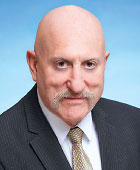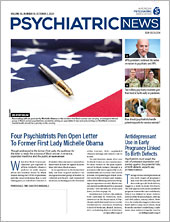Some readers have heard about the Black psychiatrist members of APA who stormed an APA Board of Trustees (BOT) meeting in 1969. Their efforts to get APA to address their professional needs, however, started well before that meeting and continued afterward. In telling this history, I am relying mainly on the APA Archives. There are no documents of that time that give the Black psychiatrists’ perspective. This history is the white psychiatrists’ version—the only version memorialized. It is an important history for it lays down the bedrock for the efforts that have occurred since then and are occurring now.
On May 29, 1963, APA Medical Director Walter Barton met with Charles Prudhomme, a Black psychiatrist who subsequently served as APA vice president for the 1970-1971 term. (He was the first nationally elected Black psychiatrist in APA’s history.) Barton’s record of this meeting states, “The general theme [was that] the colored psychiatrist* has been ignored by the APA and that it was high time the Association gave leadership to the problem rather than continue its present course of indifference.”
Prudhomme had two specific asks: (1) The APA president or another elected officer or the medical director address the National Medical Association (NMA) at its annual meeting and (2) APA host a conference of the leadership of APA and the National Institute of Mental Health (NIMH) and “twenty leading Negro psychiatrists.” The NMA was founded in 1895 by Black physicians, who were not permitted to join the whites-only AMA.
The two men discussed the need to improve the training of Black medical students and psychiatrists; the absence of Black members in APA leadership positions, the staff of NIMH, and the U.S. Public Health Service; and the “separate but equal facilities” language in the community mental health center bills before Congress. Barton thought “separate but equal” was acceptable as more Black people would receive treatment; Prudhomme rejected that argument.
Five years later, on August 29, 1968, Chester Pierce met with Barton, trying to convince him that APA should sponsor a program directed at children about 11 years old that involved personal contact to motivate the youngsters to stay in school and to follow them through their entrance into college. Barton had his doubts, but it is not clear what he told Pierce. On October 31, Barton sent a memo to the APA Manpower Commission outlining Pierce’s proposal to “recruit young Negroes into the health care industry with a hope some would go into medicine and psychiatry particularly.” Barton presented staffing and budget data.
While Barton wrote that he had found the proposal a “fascinating one and of great promise,” he was “somewhat doubtful that the role of the APA in such a project could appropriately be a very direct one.” Barton presented a second proposal from Pierce to “support Negro college students to return to medical school.” Barton opined this proposal had merit but wondered where the money to cover the costs would come from. He did say, however, that a “sample survey” would be done to determine how many employed Black college graduates would be interested in going to medical school.
It’s not clear what he and APA as an organization actually did between 1963 and the early months of 1969 to address the matters that Prudhomme and Pierce had raised, but on May 4, the day before the 1969 Annual Meeting began, the BOT passed a resolution. Was this perhaps an effort to forestall what BOT members had heard might be coming? The resolution reads:
The BOT of the APA recognizes with interest the formation of a national caucus of black psychiatrists and wishes them well in their meeting in Miami.
The Board is deeply concerned with the problems of the minority groups in our country and its institutions, [and] wishes to make progress in relation to this serious national issue. Recognizing how much remains to be accomplished, the Board holds itself in readiness to receive any proposals that the caucus of black psychiatrists may wish to transmit. ...
APA’s 1969 Annual Meeting was held in Miami from May 5 to 9. The session “Interracial Psychiatry—Psychiatrists View White Racism in America” was held on the first day of the meeting and included five presenters: James P. Corner, Charles Wilkinson, Phyllis Harrison, Hugh F. Butts, Billy E. Jones, Orlando B. Lightfoot, Donald Palmer, Donald H. Williams, and Alice Gallate. Regarding the topics they covered—white racism, racism in referrals to Black psychiatrists, Black residents in white training programs, and destructiveness of a myth—they could all be discussed today with hardly a change in the presentations necessary. Several of these presentations were published in the American Journal of Psychiatry in 1970.
Three days later, on May 8, 1969, a group of Black psychiatrists presented themselves at the BOT meeting, Prudhomme and Pierce among them, with demands for change. The number of Black psychiatrists in the group was reported to be about 100, but documentation of that number has never been found. In the BOT minutes, the demands are referred to as “9 points,” listed verbatim (see box).
In response, the APA president appointed an ad hoc committee consisting entirely of Black male psychiatrists, chaired by Chester Pierce. BOT members concluded that day that the list of demands “could not be resolved.”
In a meeting on May 12, 1969, between APA leaders and the Ad Hoc Committee on Black Psychiatry, the APA leaders wanted the Black psychiatrists to work through the Assembly structure. The Black psychiatrists rejected this, indicating that the structure was not “relevant” to them. Also, they chastised APA leaders, saying it was “white racial hang-ups the faith and structure in organization that people have.” Despite little being accomplished, APA leaders were pleased that there was “a spirit of cooperation,” an “intent to establish a dialogue,” and the “opportunity for …more vigorous advocacy. …”
On June 20, 1969, Black psychiatry leaders came to the BOT Executive Committee meeting to protest the appointment of a white psychiatrist to lead an APA-funded study of the mental health components of poverty programs. The Black psychiatrists called for the appointment of a Black individual to lead the study or the termination of the study. APA terminated the study, indicating that it had not been able to find a suitable Black psychiatrist willing to take the position and stating that without the cooperation of Black members, there was no point to the study. The Black psychiatrists pushed back, saying that now was the time for a “series of grand and generous gestures, of special accommodations, of material manifestations of good will” (Psychiatric News, July 1969). They indicated that in taking such actions (including the appointment of a Black psychiatrist to head the study), APA could have “enormous impact on amelioration of the greatest mental health problem of our time—racism in both its conscious and unconscious forms.” What did come out of the meeting was a pledge by the president to appoint a Black consultant to each of APA’s six councils and a hope that Black psychiatrists would be nominated for leadership positions in APA.
In a July 29, 1969, memo, it was noted that in March 1965 there were 207 Black psychiatrists in the United States, 156 of whom were APA members. In 1966 APA had stopped collecting membership data by race. This decision was rescinded in 1969, and the “best estimate” of the number of Black psychiatrists in the United States that year was 300 to 400. That figure was modified the next month to 300 to 325. There were 81 Black psychiatry residents.
On October 31, 1969, the Executive Board of the “Black APA Psychiatrists” unanimously passed the following resolution:
We request that the American Psychiatric Association establish a one-half time position for a Black psychiatrist at the central APA office; that such a person be suggested by or endorsed by the Black APA Psychiatrists; furthermore, that this person concern himself in depth with the issues around and related to the enhancement of, in numbers and roles, Black mental health professionals and of mental health delivery systems in Black and minority communities.
The Black psychiatrists sent this resolution to the APA president at the time, Raymond W. Waggoner, stating that they considered this an urgent matter.
The resolution was considered at the Board meeting of December 12 and 13 and was not approved. The Board indicated that “most of the functions contained in the proposed job description are already being performed by the APA manpower department.” The Board did acknowledge, however, “the desirable features of such a recommendation and suggested that alternate functions be proposed.”
At that same meeting, APA established the Solomon Carter Fuller Award, named after a pioneer in psychiatry who is recognized as the first Black psychiatrist in America. The award honors a citizen “who must be of African descent” and who has pioneered in an area that has significantly improved the quality of life for Black people.
What resulted from the activities of the Black psychiatrists in 1969? Did Board members think that in establishing the Solomon Carter Fuller Award, they had done enough for Black psychiatrists that year, giving themselves tacit permission to reject the central office position for a Black psychiatrist while saying at the same time it was a good idea?
In 1972 APA established the Minority Group Program Development Project and appointed a Black psychiatrist to be its head, Elvin Mackey Jr. That program was replaced with the Office of Minority and National Affairs, whose first director was Jeanne M. Spurlock, M.D., a pioneer in child psychiatry. She served from 1974 until her retirement in 1992. (That office was renamed the Division of Diversity and Health Equity in 2014).
Several Black psychiatrists served as vice president without being elected president: Charles Prudhomme, 1970-1971, Mildred Mitchell-Bateman, 1973-1974; and June Jackson Christmas, 1974-1975.
While APA has made incremental advances in addressing racism over the decades, it was close to 50 years from the time that the Black psychiatrists presented their demands in 1969 until APA had its first Black president. And the essence of the demands made in 1969 remains unfulfilled. If one thinks of the BOT’s action in December 1969 as kicking the can down the road, then it was a
strong kick down a
long road. Now is the time for APA to do better. APA must become relevant to its Black members and to Black patients, and it can do so, in part, by seriously examining what Black psychiatrists sought a half century ago. This is one of the goals of the work of my Presidential Task Force to Address Structural Racism Throughout Psychiatry (
Psychiatric News), and I’ll be reporting on its progress in future issues. ■
*All spelling and terms are as in the original documents.

